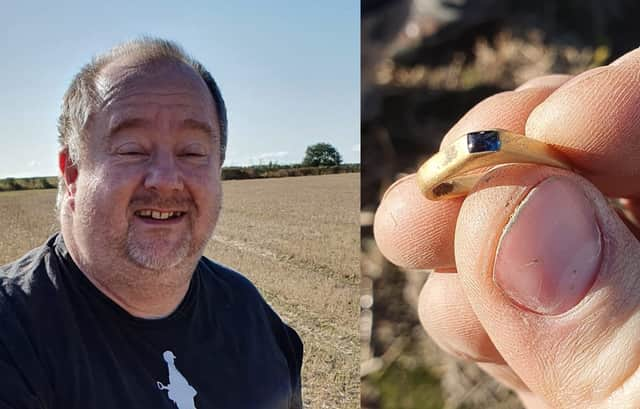Joy of metal detectorist as he unearths treasure in field near Rotherham


After seven years of roaming the countryside with his own detector, the 53-year-old grandad has finally discovered a piece of history that can be officially classed as treasure.
Three inches under the soil in a field in Clayton, Doncaster, he found a gold stirrup ring with stunning blue sapphire dating back to the 12th or 13th century.
Advertisement
Hide AdAdvertisement
Hide AdAfter a long wait for it to be assessed by the authorities, it has now been categorised as official treasure and effectively belongs to the Crown, but will be displayed in a local museum.
Such rings are as distinctive as they are rare — they were mainly worn by high-ranking clergy or royals in the middle ages.
This one is bigger and heavier than most that have been recovered.
Sean, of Treeton, said he had been thrilled by the discovery.
Advertisement
Hide AdAdvertisement
Hide AdWhile he had made finds before, this was “miles better” and the only item to be classified by the State as treasure, based on its age and precious metal content.
He has researched the object, which he thinks is mainly 24ct gold, and says: “It could have been worn by royalty or a high priest.
“Previous ones have normally been two or three grams. This was over six, so it’s a lot bigger than normal – I’ve not seen any others any bigger.
“It was laid near a tree, a couple of inches down, really not very deep, and had been there for 800 years.
Advertisement
Hide AdAdvertisement
Hide Ad“I wondered how this expensive ring would have been lost, which would have cost a year’s wage for the normal person.
“Did it belong to somebody famous in that time? A sapphire usually represents the Virgin Mary so it was a good chance it had belonged to a clergyman who wore it over a glove.”
The former Swinton Comp pupil added: “A bloke at the site immediately recognised it as a stirrup ring.
“When he told me what it was, I ran over to the local farmer to tell him. He and his wife were really pleased.”
Advertisement
Hide AdAdvertisement
Hide AdSean, a father of four and production planner at a company near Meadowhall, took the item to the Finds Liaison Officer and after several months it has now been declared as treasure.
“I was sorry to see it go, but proud it is going to a museum, as long as it doesn’t end up in a drawer,” he added.
Sean can sell it to the museum, possibly for upwards of £3,600, and split the proceeds with the farmer.
It’s not about the money though, the excitement of digging up history has spurred him on to make more finds in the future.
“The first time I went out with my new detector I found a quarter guinea (from the 1700s) which are quite rare,” Sean added.
“The next thing I might find could be a Saxon gold brooch or something.”